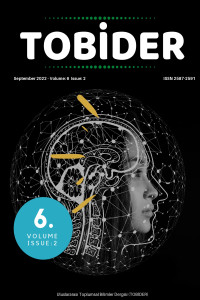Öz
Filozoflar arasında cereyan etmiş töz hakkındaki tartışmalar bakımından, günümüze Yeniçağ’dan hayli zengin bir literatür miras kalmıştır. Söz konusu literatürde, Hobbes, Descartes, Leibniz, Locke, Spinoza gibi dönemin meşhur filozofların eserleri öne çıkmaktadır. Kaleme almış olduğu tek eseriyle Anne Conway’in adı ise meşhur olmamıştır. Oysa Conway bu onto-teolojik eserinde, Kartezyen düalist metafiziğe yönelik güçlü bir reddiye ortaya koymuştur. Biri maddî, diğeriyse gayrimaddî-spiritüel olmak üzere, birbirinden apayrı iki tür tözün mevcut olduğuna dair Kartezyen fikri eleştirmiştir. Conway’in düalizm bağlamında eleştiri oklarını açıkça yönlendirdiği Descartes dışında, hedef tahtasına yerleştirdiği ikinci bir filozof da vardır: Conway’in yakın dostu Henry More. “Ateizme karşı panzehir” başlığıyla kaleme aldığı risâlesini Conway’e ithaf etmiş olan More, âtıl madde ve aktif gayrimaddî ruh [spirit] olmak üzere iki tür töz bulunduğuna inanır. Conway düalizm eleştirisine, yurttaşı Hobbes’un saf maddî töz inancını dayanak almamıştır. Conway’e göre tek tür töz vardır ve o ne saf spiritüeldir ne de saf maddî. Ne materyalist ne de spiritüalist bir pozisyonda duran Conway açısından “maddî” ve “spiritüel” denen şeyler, aslında sadece ikisinden birinden ibaret olmayan tek bir tür tözün farklı “hâller”idir. Makelemizde Conway’in fikirleri ile Leibniz’in ontolojisi arasındaki benzerliğe ve farklılığa da değineceğiz. Böylece, makalemizin sonuç bölümünde, yaşadığı çağın önde gelen filozoflarının töz anlayışları karşısında Conway’in özgün pozisyonunu belirginleştirmeye çalışacağız.
Anahtar Kelimeler
Yeniçağ felsefesi ontoloji zihin felsefesi töz problemi zihin-beden problemi.
Kaynakça
- Boyle, D. (2006). “Spontaneous and Sexual Generation in Conway’s Principles”. in Smith, Justin E. H. (ed.), The Problem of Animal Generation in Early Modern Philosophy, Cambridge: Cambridge University Press, pp. 175-194.
- Conway, A. (2020). En Kadim ve Modern Felsefenin İlkeleri. Çev: Ferit Burak Aydar. İstanbul: İş Bankası Kültür yay.
- Derksen, L. D. (1998). “Anne Conway’s Critique of Cartesian Dualism”. https://www.bu.edu/wcp/Papers/Onto/OntoDerk.htm
- Descartes, R. (1824). Les principes de la philosophie. in Œuvres de Descartes, tome: III, (éd. par Victor Cousin), Paris: chez F. G. Levrault.
- Descartes, R. (1995). Les Passions de l’âme, Paris: Bookking International.
- Gordon-Roth, J. (2018). “What Kind of Monist is Anne Finch Conway?”. Journal of the American Philosophical Association, volume 4, issue 3, fall 2018, pp. 280-297. DOI: https://doi.org/10.1017/apa.2018.24
- Head, J. (2020). The Philosophy of Anne Conway: God, Creation and the Nature of Time. Bloomsbury Publishing.
- Henry, J. (2008). “Henry More”. Stanford Encyclopedia of Philosophy. Erişim adresi: https://plato.stanford.edu/entries/henry-more/
- Hutton, S. (2003). “Lady Anne Conway” maddesi, Stanford Encyclopedia of Philosophy. Erişim adresi: https://plato.stanford.edu/entries/conway/
- Hutton, S. (2004). Anne Conway: A Woman Philosopher. New York: Cambridge University Press.
- More, H. (2022). An Antidote against to Atheism. Erişim adresi: https://en.wikisource.org/wiki/An_Antidote_Against_Atheism
- Priest, S. (2018). Zihin Üzerine Teoriler. Çev: Ayhan Dereko, İstanbul: Litera yay.
- Robinson, H. (2004). “substance”, Stanford Encyclopedia of Philosophy, Erişim adresi: https://plato.stanford.edu/entries/substance/
Öz
In terms of the debates about substance that took place among philosophers, a very rich literature has been inherited today from the Early Modern Age. In the mentioned literature, the works of famous philosophers of the period such as Hobbes, Descartes, Leibniz, Locke, Spinoza come to the fore. Anne Conway’s name did not gain fame with the only work she wrote. However, in this onto-theological work, Conway put forward a strong refutation towards Cartesian dualist metaphysics. She criticized the Cartesian conception that there are two distinct types of substance, one material and the other immaterial-spiritual. Apart from Descartes, to whom Conway clearly directs the arrows of criticism in the context of dualism, there is a second philosopher placed on the target: Conway’s close friend Henry More. Dedicating his treatise “Antidote against to atheism” to Conway, he believes that there are two types of substances: Inert matter and active immaterial spirit. Conway did not base her critique of dualism on his compatriot Hobbes’ belief in pure material substance. According to Conway, there is only one type of substance, and it is neither purely spiritual nor purely material. For Conway, who is neither materialist nor spiritualist, things called “material” and “spiritual” are different “modes” of a single type of substance, which is not actually just one of the two. In our article, we will also touch on the similarities and differences between Conway’s ideas and Leibniz’s ontology. Thus, in the conclusion part of our article, we will try to clarify Conway’s original position against the substance understandings of the leading philosophers of her age.
Anahtar Kelimeler
Early modern philosophy ontology philosophy of mind substance problem mind-body problem
Kaynakça
- Boyle, D. (2006). “Spontaneous and Sexual Generation in Conway’s Principles”. in Smith, Justin E. H. (ed.), The Problem of Animal Generation in Early Modern Philosophy, Cambridge: Cambridge University Press, pp. 175-194.
- Conway, A. (2020). En Kadim ve Modern Felsefenin İlkeleri. Çev: Ferit Burak Aydar. İstanbul: İş Bankası Kültür yay.
- Derksen, L. D. (1998). “Anne Conway’s Critique of Cartesian Dualism”. https://www.bu.edu/wcp/Papers/Onto/OntoDerk.htm
- Descartes, R. (1824). Les principes de la philosophie. in Œuvres de Descartes, tome: III, (éd. par Victor Cousin), Paris: chez F. G. Levrault.
- Descartes, R. (1995). Les Passions de l’âme, Paris: Bookking International.
- Gordon-Roth, J. (2018). “What Kind of Monist is Anne Finch Conway?”. Journal of the American Philosophical Association, volume 4, issue 3, fall 2018, pp. 280-297. DOI: https://doi.org/10.1017/apa.2018.24
- Head, J. (2020). The Philosophy of Anne Conway: God, Creation and the Nature of Time. Bloomsbury Publishing.
- Henry, J. (2008). “Henry More”. Stanford Encyclopedia of Philosophy. Erişim adresi: https://plato.stanford.edu/entries/henry-more/
- Hutton, S. (2003). “Lady Anne Conway” maddesi, Stanford Encyclopedia of Philosophy. Erişim adresi: https://plato.stanford.edu/entries/conway/
- Hutton, S. (2004). Anne Conway: A Woman Philosopher. New York: Cambridge University Press.
- More, H. (2022). An Antidote against to Atheism. Erişim adresi: https://en.wikisource.org/wiki/An_Antidote_Against_Atheism
- Priest, S. (2018). Zihin Üzerine Teoriler. Çev: Ayhan Dereko, İstanbul: Litera yay.
- Robinson, H. (2004). “substance”, Stanford Encyclopedia of Philosophy, Erişim adresi: https://plato.stanford.edu/entries/substance/
Ayrıntılar
| Birincil Dil | Türkçe |
|---|---|
| Bölüm | Uluslararası Toplumsal Bilimler Dergisi Cilt 6 Sayı 2 |
| Yazarlar | |
| Yayımlanma Tarihi | 1 Ekim 2022 |
| Yayımlandığı Sayı | Yıl 2022 Cilt: 6 Sayı: 2 |


